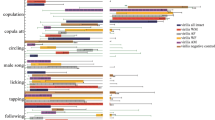Abstract
The lack of basiconic antennal sensilla in the mutantlozenge 3 was used to assess the role of these olfactory receptors in the courtship behavior ofDrosophila melanogaster. Under normal light conditions,lozenge 3 males courted virgin females much less than wild-type males did. However, when visual courtship stimuli were eliminated by studying behavior under dim red light, the two kinds of males courted individual wild-type virgin females with the same intensity, and the latency to copulation was similar. Also, no difference in courtship vigor was observed if the two kinds of males were paired in red light with a mated female. These data suggest that antennal basiconic sensilla are important for neither the perception of the attraction pheromone(s) of virgin females nor the inhibitory pheromone(s) of mated females. Similar assays with males deprived of maxillary palps make it unlikely that the basiconic-like sensilla on these appendages are needed to perceive the attraction pheromones. However, the unexpectedly high courtship activity of palp-deprived males toward mated females suggests that basiconic-like maxillary sensilla may be receptors of inhibitory female compounds.
Similar content being viewed by others
References
Antony, C., and Jallon, J.-M. (1981). Evolution des hydrocarbures comportalement actifs deDrosophila melanogaster au cours de la maturation sexuelle.C.R. Acad. Sci. Paris 292:239–242.
Benzer, S. (1967). Behavioral mutants ofDrosophila isolated by counter-current distribution.Proc. Natl. Acad. Sci. USA 58:1112–1119.
Borst, A. (1984). Identification of different chemoreceptors by electroantennogram-recording.J. Insect Physiol. 30:507–510.
Fischbach, K.-F., and Technau, G. (1984). Cell degeneration in the developing optic lobes of thesine oculis andsmall optic lobes mutants ofDrosophila.Dev. Biol. 104:219–239.
Gailey, D. A., Lacaillade, R. C., and Hall, J. C. (1986). Chemosensory elements of courtship in normal and mutant, olfaction-deficientDrosophila melanogaster.Behav. Genet. 16:375–405.
Hall, J. C. (1986). Learning and rhythms in courting, mutantDrosophila.Trends Neurosci. 9:414–418.
Hall, J. C., Alahiotis, S. N., Strumpf, D., and White, K. (1980). Behavioral and biochemical defects in temperature-sensitive acetylcholinesterase mutants ofDrosophila melanogaster.Genetics 96:939–965.
Hotta, Y., and Benzer, S. (1976). Courtship inDrosophila mosaics: Sex-specific foci for sequential action patterns.Proc. Natl. Acad. Sci. USA 73:4154–4158.
Jallon, J.-M. (1984). A few chemical words exchanged byDrosophila during courtship and mating.Behav. Genet. 14:441–478.
Jallon, J.-M., Antony, C., and Benamar, O. (1981). Un anti-aphrodisiaque produit par les malesDrosophila melanogaster est transféré aux femelles lors de la copulation.C.R. Acad. Sci. Paris 292:1147–1149.
Kulkarni, S. J., Steinlauf, A. F., and Hall, J. C. (1988). Thedissonance mutant of courtship song inDrosophila melanogaster: Isolation, behavior and cytogenetics.Genetics 118:267–285.
Link, B. (1983).Raster- und TEM Analyse der Sensillen des mesothorakalen Beines und des dritten Antennensegmentes von Drosophila melanogaster, Diploma thesis, University of Fribourg, Fribourg, Switzerland.
Mane, S. D., Tompkins, L., and Richmond, R. C. (1983). Male esterase 6 catalyzes the synthesis of a sex pheromone inDrosophila melanogaster females.Science 222:419–422.
Markow, T. A., and Hanson, S. J. (1981). Multivariate analysis ofDrosophila courtship.Proc. Natl. Acad. Sci. USA 78:430–434.
McEwen, R. S. (1918). The reactions to light and gravity inDrosophila and its mutants.J. Exp. Zool. 25:49–106.
Meyerowitz, E. M., and Kankel, D. R. (1978). A genetic analysis of visual system development inDrosophila melanogaster.Dev. Biol. 62:112–142.
Pak, W. L., Grossfield, J., and White, N. V. (1969). Nonphototactic mutants in a study of vision ofDrosophila.Nature 222:351–354.
Robertson, H. M. (1983). Chemical stimuli eliciting courtship by males inDrosophila melanogaster.Experientia 39:333–335.
Schäffel, F., and Willmund, R. (1985). Visual signals in the courtship ofDrosophila melanogaster: Mutant analysis.J. Insect Physiol. 31:899–907.
Scott, D., and Richmond, R. C. (1987). Evidence against an anti-aphrodisiac role for cisvaccenyl acetate inDrosophila melanogaster.J. Insect Physiol. 33:363–369.
Siddiqi, O. (1983). Olfactory neurogenetics ofDrosophila. In Chopra, V. L., Joshi, B. C., Sharma, R. P., and Bawal, H. C. (eds.),Genetics: New Frontiers, Vol III, Oxford University Press & IBH, London/New York, pp. 242–261.
Siddiqi, O. (1987). Neurogenetics of olfaction inDrosophila melanogaster.Trends Genet. 3:137–142.
Siegel, R. W., and Hall, J. C. (1979). Conditioned responses in courtship behavior of normal and mutantDrosophila.Proc. Natl. Acad. Sci. USA 76:3430–3434.
Singh, R. N., and Nayak, S. V. (1985). Fine structure and primary sensory projections of sensilla on the maxillary palp ofDrosophila melanogaster Meigen (Diptera: Drosophilidae).Int. J. Insect Morphol. Embryol. 14:291–306.
Steinbrecht, R. A. (1973). Der Feinbau olfaktorischer Sensillen des Seidenspinners (Insecta, Lepidoptera).Z. Zellforsch. 139:533–565.
Stocker, R. F., and Gendre, N. (1988). Peripheral and central nervous effects oflozenge 3: ADrosophila mutant lacking basiconic antennal sensilla.Dev. Biol. 127:12–24.
Tompkins, L. (1984). Genetic analysis of sex appeal inDrosophila.Behav. Genet. 14:411–440.
Tompkins, L., Hall, J. C., and Hall, L. M. (1980). Courtship stimulating volatile compounds from normal and mutantDrosophila.J. Insect Physiol. 26:689–697.
Tompkins, L., Gross, A. C., Hall, J. C., Gailey, D. A., and Siegel, R. W. (1982). The role of female movement in the sexual behavior ofDrosophila melanogaster.Behav. Genet. 12:295–307.
Venard, R., and Pichon, Y. (1981). Etude électro-antennographique de la réponse périphérique de l'antenne deDrosophila melanogaster à des stimulations odorantes.C.R. Acad. Sci. Paris 293:839–841.
Venard, R., and Pichon, Y. (1984). Electrophysiological analysis of the peripheral response to odours in wildtype and smell-deficientolfC mutant ofDrosophila melanogaster.J. Insect Physiol. 30:1–5.
Author information
Authors and Affiliations
Additional information
This study was supported by Swiss National Foundation Grant 3.239-0.85.
Rights and permissions
About this article
Cite this article
Stocker, R.F., Gendre, N. Courtship behavior ofDrosophila genetically or surgically deprived of basiconic sensilla. Behav Genet 19, 371–385 (1989). https://doi.org/10.1007/BF01066165
Received:
Accepted:
Issue Date:
DOI: https://doi.org/10.1007/BF01066165




